- Reclamation
- Upper Colorado Basin
- Power Office
Power Office
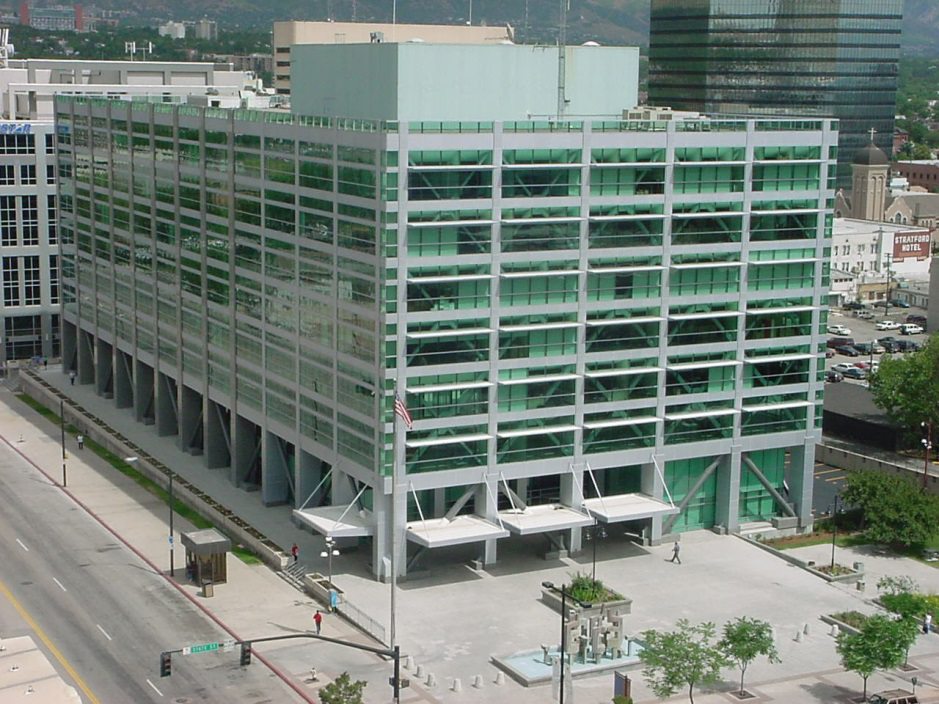
125 South State Street, Room 8100
Salt Lake City, Utah 84138-1147
- About Us
- Hydropower
- Overview of Upper Colorado Powerplant Ownership and Operation
- Power Marketing
- Power System Operation
About Us
The Upper Colorado Basin Region's Power Office, located in Salt Lake City, Utah, oversees four field offices associated with primary Colorado River Storage Project and the Rio Grande hydroelectric power generation facilities:
- Glen Canyon Field Division in Page, Arizona.
- Curecanti Field Division in Montrose, Colorado.
- Flaming Gorge Field Division in Dutch John, Utah.
- Elephant Butte Field Division in Truth or Consequences, New Mexico
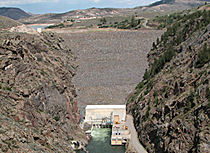
Power Office employees are responsible for operating and maintaining the CRSP hydroelectric powerplants and dams which include Flaming Gorge on the Green River near Dutch John, Utah; Blue Mesa, Morrow Point, and Crystal on the Gunnison River near Montrose, Colorado: and Glen Canyon on the Colorado River near Page, Arizona. The Power Office also operates and maintains facilities at other Reclamation projects including Fontenelle Dam and Powerplant on the Green River near Kemmerer, Wyoming; and the Upper and Lower Molina Powerplants near Grand Junction, Colorado and Elephant Butte Dam and Powerplant on the Rio Grande River near Truth or Consequences, New Mexico. In addition, the Power Office is responsible for ensuring the structural safety and security of all these dams and powerplants.
The reservoirs associated with these projects have a combined water storage capacity of approximately 32.6 million acre-feet providing benefits for flood control, municipal and industrial water use, irrigation, recreation, fish and wildlife, and power generation. The powerplants provide a clean, renewable source of energy, generating an average of 5,750,000,000 kilowatt-hours of energy annually. The power is delivered to the Western Area Power Administration for transmission and marketing to public and municipal entities in the states of Utah, Wyoming, Nebraska, Colorado, New Mexico, Arizona, and Nevada.
The Power Office works closely with Western Area Power Administration and our federal power customers to establish a power rate to collect revenue and repay the United States Treasury for the cost of constructing the power facilities and other project costs allocated for power revenue to repay including recovery of the cost of operating and maintaining the power facilities.
Power produced at these facilities is also provided for use on Reclamation projects in the Upper Colorado Region. The Power Office administers contracts to provide power to the Central Utah Project, Silt Project, Dolores Project, Navajo Indian Irrigation Project, Paradox Project, and Animas-La Plata Project.
Non-federal power development at Reclamation facilities in the Upper Colorado Region is handled through a lease of power privilege from Reclamation or by license from the Federal Energy Regulatory Commission which is administered by the Power Office.
Return to TopHydropower
Hydropower Generation Basics
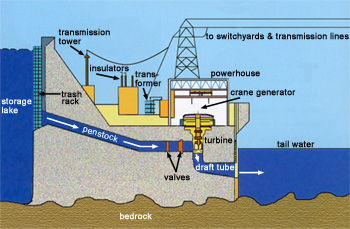
The process of generating electrical power involves converting one form of energy to another. Energy can never be created or destroyed but it can change form. Hydroelectric power production converts moving water into electrical power. Kinetic, or moving energy, is created by water in motion such as a waterfall or river. The amount of kinetic energy created depends on the speed of the moving water which varies depending on factors such as streamflow and change in elevation (head).
To generate hydroelectricity, water from a river or reservoir is directed into a large pipe called a penstock. Water flows from the penstock through the turbine, causing the turbine to rotate at a fast speed. The turbine is connected to a rotor by a shaft, so the rotor rotates at the same speed as the turbine. The outside edge of the rotor is made up of very strong electromagnets connected in a way to provide alternating polarity around the rotor.
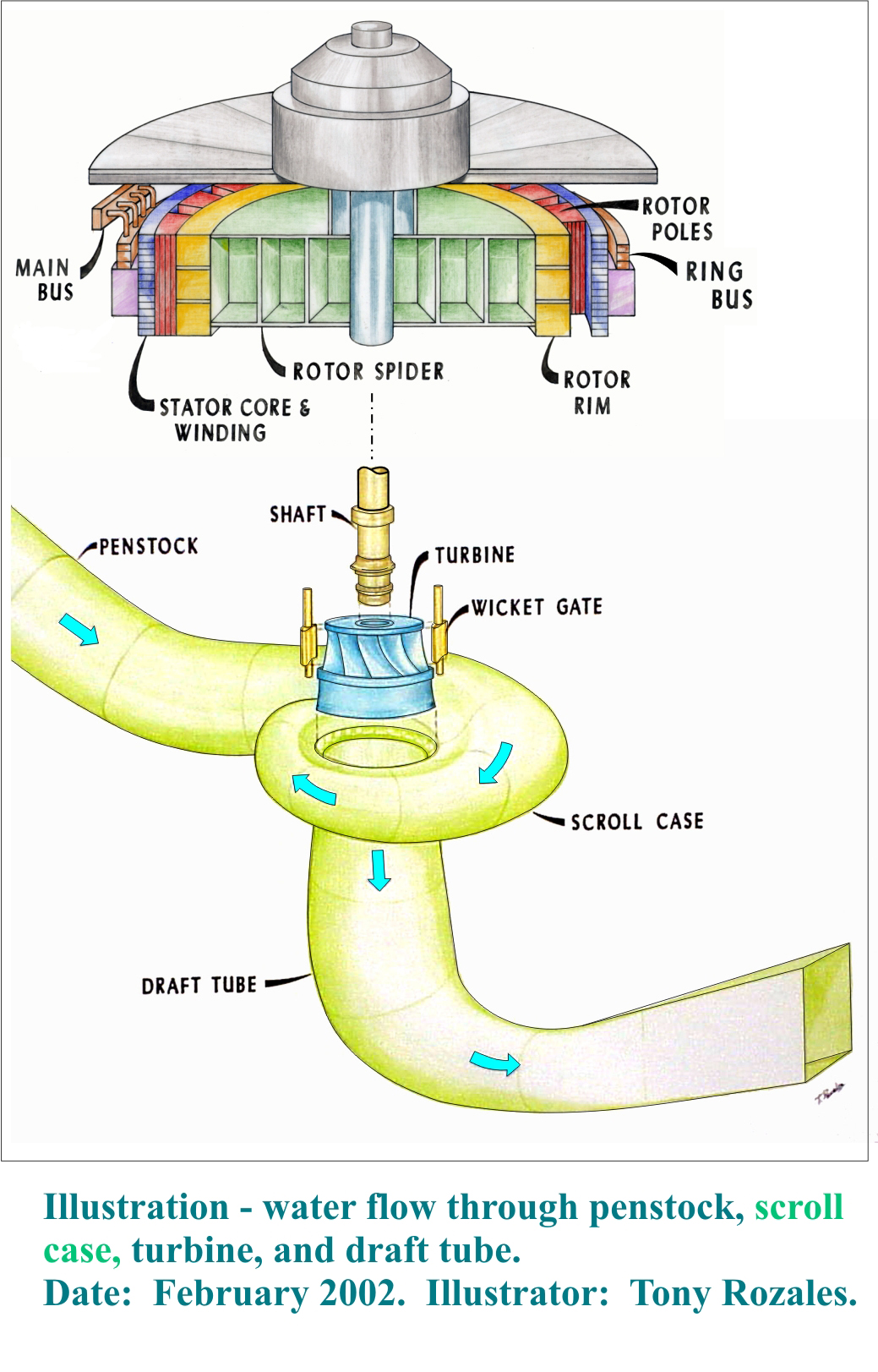
Another generator part is called a stator. The stator encompasses the rotor, is made of steel with many coils of small copper wire inside and is placed close to the rotor. The energy produced by the water pressure turning the turbine and rotor, combined with the strong electromagnets, creates voltage across the stator coils which are connected in patterns that allow the voltage to be controlled. By changing the strength of the magnets on the rotor and the amount of the water flowing in the penstock, the amount of electricity being generated can be regulated.
Once generated, the electricity is conveyed to transformers via large copper bars called buses, where it is converted to a very high voltage for long-distance transmission to power customers.
Benefits of Hydropower
There are many benefits provided by hydropower over other energy sources. These include:
- Clean – Because hydropower uses water to generate electricity, it doesn’t produce air pollution or create toxic by-products like powerplants that burn fossil fuels such as coal or natural gas.
- Renewable – Hydropower is renewable because it relies on the hydrological (water) cycle driven by the sun which provides a renewable supply of water. Hydropower facilities harness the natural energy of flowing and falling water to generate electricity. About 96 percent of the United States' renewable energy comes from hydropower.1
- Reliable – Hydropower can meet changing demands because it can go from zero power to maximum output rapidly and predictably.2
- Efficient – Today's hydropower turbines can convert more than 90 percent of available energy into electricity which is more efficient than any other form of generation (the best fossil fuel powerplant is only about 50 percent efficient).3
- Flexible – Hydropower output can be changed quickly in response to changes in electrical demand because of the ability to control the flow of water. This ability is considered essential to electric transmission grid stability.4
- Domestic and Secure – Hydropower is a secure source of energy because it comes from water in domestic rivers and is not subject to disruptions from foreign suppliers, cost fluctuations, and transportation issues that are associated with other fuel sources.5
- Cost-Effective – Hydropower generation has low operating costs and a long powerplant life compared with other large scale power-generating options. Once the first investment is made, powerplant life can be extended economically and remain in service for many years. Typically a hydropower plant in service for 40-50 years can have its operating life doubled.6
- Stored Energy Source – Because hydropower is most often generated by water stored in a reservoir behind a dam, a vast amount of potential energy exists in the reservoir which is available over a long period of time.
- Black Start Capability – Hydropower facilities can start generation without an outside source of power. This service allows system operators to supply auxiliary power to more complex generation sources that could take hours or even days to start.7
- Growth and Development – Hydropower has played in important role in the growth and development of the Western United States and in the Nation's electric power industry. Both large and small hydroelectric power developments were instrumental in the early expansion of the electric power industry.
- The Future – Hydroelectric power is important to the United States. Growing populations and modern technologies require vast amounts of electricity for creating, building, and expanding. Hydropower currently supplies about 10 percent of the electrical generating capacity of the US.8
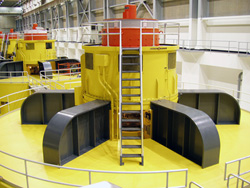
1,4,8 Bureau of Reclamation, Power Resources Office, Hydroelectric Power, (July 2005)
2,3,5 National Association of Hydropower (www.hydro.org/Hydro_Facts/Facts_Sheets/716.cfm)
6,7 International Hydropower Association, Hydropower and the Worlds Energy Future, (November 2000)
Hydropower Program
The Bureau of Reclamation has a long and successful history supplying renewable, clean, reliable, and affordable hydropower to its customers. As the operating environment has evolved over the past century, Reclamation has adapted, using new technologies and partnerships to meet the nation's water and energy needs. For more information, visit Reclamation's Hydropower Program site.
Return to TopOverview of Upper Colorado Powerplant Ownership and Operation
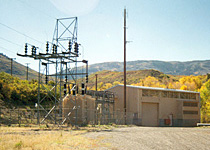
bank of Cottonwood Creek, Colorado
There are 28 hydroelectric powerplants, including one under construction, at Reclamation projects in the Upper Colorado Region. Of the 28 powerplants, 20 are owned by Reclamation and eight are owned by private entities either under a lease of power privilege (Lease) issued by Reclamation or by a license from the Federal Energy Regulatory Commission. The distinction between a Lease and a FERC license is that a FERC license may be issued at a Reclamation project where the development of power is not an authorized purpose of the Reclamation project. The FERC is an agency of the United States Department of Energy, and among other things, has jurisdiction over hydroelectric licensing in the United States except at those Reclamation projects where Congress has given authority to Reclamation.
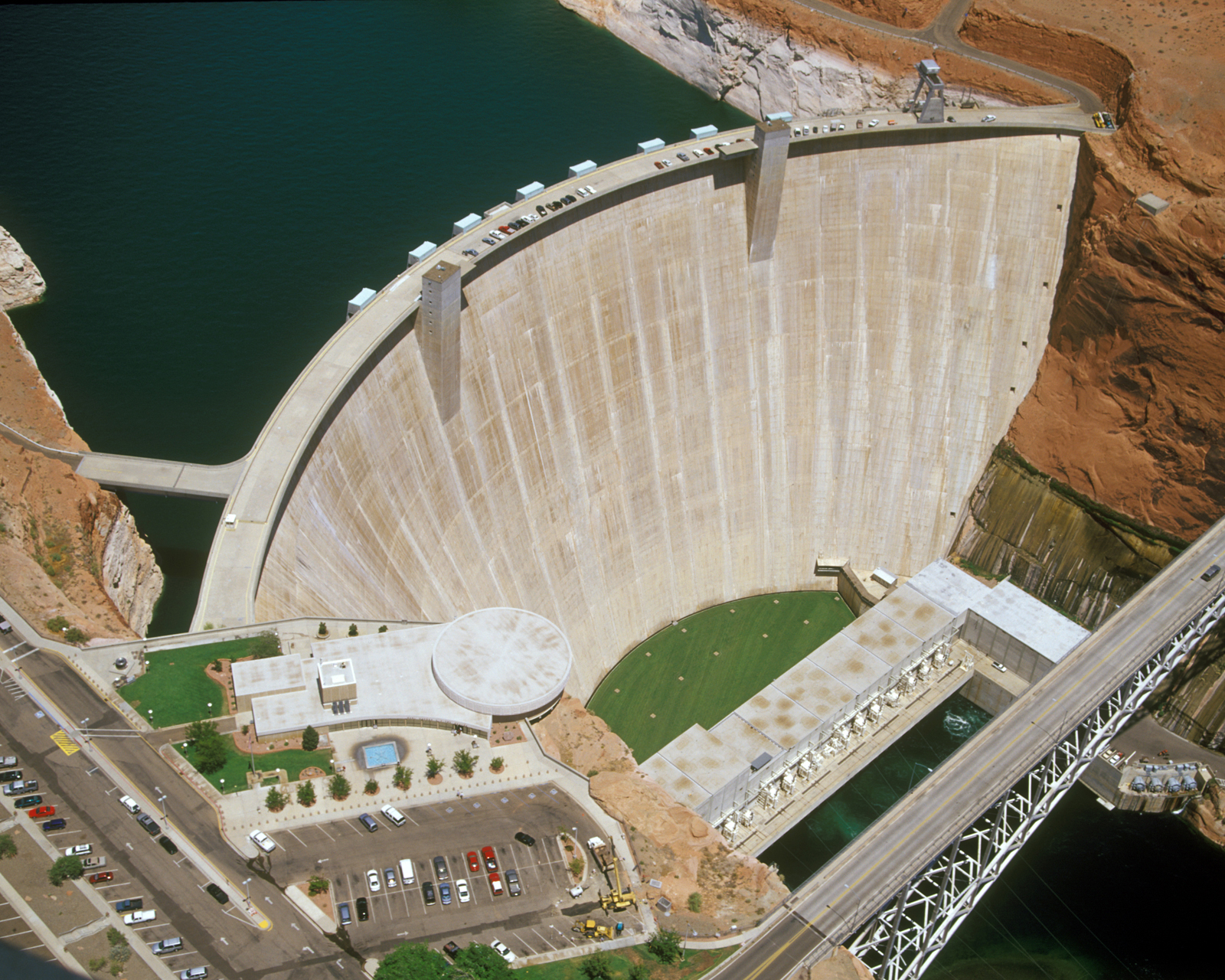
Of the nine powerplants owned and operated by Reclamation, the Power Office's Flaming Gorge Field Division operates and maintains the facilities associated with the Flaming Gorge and Fontenelle Powerplants; the Curecanti Field Division operates and maintains the facilities associated with the Blue Mesa, Morrow Point, Crystal, Upper Molina and Lower Molina Powerplants; and the Glen Canyon Field Division operates and maintains the facilities associated with the Glen Canyon Powerplant; and the Elephant Butte Field Division operates and maintains the facilities for Elephant Butte and Caballo Dam as well as the Powerplant.
| Project | Powerplant | State | River | Initial Date In Service | Number of Units | Installed Capacity in kW |
|---|---|---|---|---|---|---|
| Collbran | Lower Molina | Colorado | Pipeline | Dec. 1962 | 1 | 4,860 kW |
| Collbran | Upper Molina | Colorado | Pipeline | Dec. 1962 | 1 | 8,640 kW |
| Colorado River Storage Project | Blue Mesa | Colorado | Gunnison | Sept. 1967 | 2 | 86,400 kW |
| Colorado River Storage Project | Crystal | Colorado | Gunnison | Aug. 1978 | 1 | 31,500 kW |
| Colorado River Storage Project | Morrow Point | Colorado | Gunnison | Dec. 1970 | 2 | 165,000 kW |
| Colorado River Storage Project | Flaming Gorge | Utah | Green | Nov. 1963 | 3 | 151,490 kW |
| Colorado River Storage Project | Glen Canyon | Arizona | Colorado | Sept. 1964 | 8 | 1,320,000 kW |
| Rio Grande | Elephant Butte | New Mexico | Rio Grande | Dec. 1940 | 3 | 27,900 kW |
| Seedskadee | Fontenelle | Wyoming | Green | May 1968 | 1 | 10,000 kW |
| Project | Powerplant | State | River | Initial Date In Service | Number of Units | Installed Capacity in kW |
|---|---|---|---|---|---|---|
| Central Utah | Olmsted | Utah | Pipeline | N/A | 3 | 10,300 kW |
| Dolores | McPhee | Colorado | Dolores | N/A | 1 | 1,283 kW |
| Dolores | Towaoc | Colorado | Canal | N/A | 1 | 11,495 kW |
| Provo River | Deer Creek | Utah | Provo | N/A | 2 | 4,950 kW |
| Strawberry | Upper Strawberry | Utah | Canal | N/A | 2 | 3,500 kW |
| Strawberry | Lower Strawberry | Utah | Canal | N/A | 1 | 250 kW |
| Strawberry | Payson | Utah | Pipeline | N/A | 1 | 400 kW |
| Weber Basin | Gateway | Utah | Canal | N/A | 2 | 4,500 kW |
| Weber Basin | Wanship | Utah | Weber | N/A | 1 | 1,950 kW |
| Weber Basin | Causey | Utah | Ogden | N/A | 2 | 2,200 kW |
| Project | Powerplant | State | River | Initial Date In Service | Number of Units | Installed Capacity in kW |
|---|---|---|---|---|---|---|
| Central Utah | Jordanelle | Utah | Provo | N/A | 2 | 13,000 kW |
| Grand Valley | Grand Valley | Colorado | Canal | N/A | 2 | 3,000 kW |
| Florida | Lemon | Colorado | Florida | N/A | 1 | 120 kW |
| Mancos | Jackson Gulch | Colorado | Canal | N/A | 1 | 260 kW |
| Project | Powerplant | State | River | Initial Date In Service | Number of Units | Installed Capacity in kW |
|---|---|---|---|---|---|---|
| Colorado River Storage Project | Navajo | New Mexico | San Juan | N/A | 2 | 30,000 kW |
| Middle Rio Grande | El Vado | New Mexico | Rio Chama | N/A | 1 | 8,000 kW |
| Ogden River | Pineview | Utah | Ogden | N/A | 1 | 1,800 kW |
| Pine River | Vallecito | Colorado | Pine River | N/A | 3 | 5,844 kW |
| Weber River | Echo | Utah | Weber | N/A | 3 | 4,500 kW |
Power Marketing
Power produced from Colorado River Storage Project and other Reclamation power facilities in the Upper Colorado Region is marketed by the Western Area Power Administration and is sold to municipalities, public utilities, and government agencies in Wyoming, Utah, Colorado, New Mexico, Arizona, Nebraska, and Nevada. WAPAs CRSP Management in Salt Lake City markets power from CRSP power resources and hydroelectric powerplants of the Collbran and Rio Grande projects, which are collectively known as the Salt Lake City Area Integrated Projects. The SLCA/IP is part of an interconnected generation and transmission system that includes federal, public, and private power generating facilities. Western is also responsible for construction, operation, and maintenance of transmission lines and associated facilities.
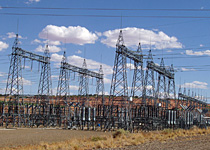
There are approximately 5,800,000 customers who receive electricity from generation facilities in the Upper Colorado Basin Region. CRSP power customers consist of:
- small and medium-sized towns that operate publicly owned electrical systems,
- irrigation cooperatives and water conservation districts,
- rural electrical associations or generation and transmission co-operatives who are wholesalers to these associations,
- municipal joint action agencies who are wholesalers to municipal electric utilities,
- federal facilities such as U.S. Air Force bases,
- universities and other state agencies, and
- Indian tribes.
Rural electric associations that buy power from CRSP serve the rural areas of states. In Colorado and New Mexico, for example, CRSP customers serve almost all of the geographic area of the state outside of the major metropolitan areas. The CRSP electrical resource is approximately 20 percent of the total electrical needs of these customers. The reliance on CRSP power varies considerably among customers, with some customers receiving virtually all of their electrical service from the CRSP. The Colorado River Energy Distributors Association, a non-profit organization, represents a majority of consumer-owned electric systems that purchase federal hydropower and resources of the CRSP.
Return to TopPower System Operation
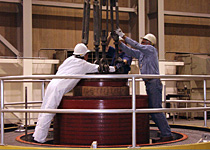
Glen Canyon Dam
Reclamation and Western Area Power Administration work together on a daily basis in scheduling water releases, developing generation schedules, and coordinating maintenance outages. WAPA transmits and dispatches power generation from each Reclamation facility and ensures compliance with minimum and maximum flow requirements and other constraints set by Reclamation in consultation with other federal, state, and local entities. In generating and dispatching power, Reclamation and Western must also consider their responsibilities associated with North American Electric Reliability Council and Western Electricity Coordinating Council criteria. WECC, as a regional council of the NERC, has responsibility for coordinating and promoting electric system reliability in the provinces of Alberta and British Columbia, the northern part of Baja California, Mexico, and all or portions of the 14 Western states in between.
NERC and WECC operating criteria require WAPA and Reclamation to meet scheduled load changes by ramping the generators up or down beginning at 10 minutes before the hour and ending at 10 minutes after the hour. Ramping is the change in the water release from the reservoir through the turbine to meet the electrical load (or power demand). Both scheduled and unscheduled ramping are crucial in load following, ancillary services, power system regulation, emergency situations, and variations in real time – what happens compared to what was scheduled – operations.
Typically, power demand increases during the daylight hours as residences, commercial establishments, agriculture and industry put electricity to use. Hydropower generation can react instantaneously to the load – a pattern called load following. By comparison, coal and nuclear based resources have a relatively slow response time; consequently, they generally have limited load following capability in the WECC.
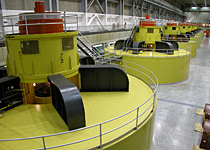
As a control area operator, WAPA regulates the transmission system within a prescribed geographic area. WAPA must react to moment-by-moment changes in electrical demand within this area, adjusting the electrical power output of hydroelectric generators within the area in response to changes in the generation and transmission system to maintain the scheduled level of generation in accordance with prescribed NERC criteria. Automatic Generation Control is a process whereby the control system automates the water releases in a manner that follows the power system’s actual dynamic demands on a moment-to-moment – typically a four-second interval – basis.
In regulating the transmission system, WAPA needs to be able to ramp releases up or down quickly in response to system conditions. In addition, each utility must have sufficient generating capacity – in varying forms of readiness – to continue serving its customer load, even if the utility loses all or part of its own largest generating unit or largest capacity transmission line. This reserve capacity ensures electrical service reliability and an uninterrupted power supply.
Reserve generating capacity that is connected to the transmission system is called spinning reserve. Spinning reserves are used to quickly replace lost electrical generation resulting from a forced outage, such as the sudden loss of a major transmission line or generating unit. More off-line generating units are also used to replace generation shortages, but they cannot replace lost generation capacity as quickly as spinning reserves.
Return to Top
